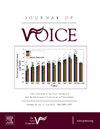Auditory-perceptual Parameters as Predictors of Voice Acoustic Measures
IF 2.4
4区 医学
Q1 AUDIOLOGY & SPEECH-LANGUAGE PATHOLOGY
引用次数: 0
Abstract
Background
Much research has examined the relationship between perceptual and acoustic measures. However, little is known about the prediction values of perceptual measures on an acoustic parameter.
Aims
This study utilized simulated and disordered voice samples to investigate the prediction values of breathiness, roughness, and strain ratings on the selection of some time-based and spectral-based measures of voice quality.
Method
This study retrospectively analysed two sets of precollected data. The experimental data had been collected from nine trained speakers manipulating false vocal fold activity, true vocal fold mass, and larynx height. The voice-disordered data had been extracted from a clinical database for 68 patients with muscle tension voice disorders (MTVD). Both data sets had been perceptually rated for breathiness, roughness, and strain. Voice samples (prolonged vowel /ɑ/ and Rainbow Passage readings) had undergone acoustic analysis using Praat for harmonics-to-noise ratio (HNR) and the program “Analysis of Dysphonia in Speech and Voice” (ADSV) for cepstral peak prominence (CPP), Cepstral/Spectral Index of Dysphonia (CSID), and Low/High spectral ratio (L/H ratio). Perceptual parameters were regressed against these acoustic measures to test their prediction values.
Results
Reliability data showed satisfactory intra- and inter-reliability of perceptual ratings for both data sets. Breathiness significantly predicted CPP (both vocal tasks) and CSID (Rainbow Passage) in experimental data and predicted all the acoustic measures in MTVD data. Roughness significantly predicted HNR, CPP, and CSID in experimental data, and CPP (Rainbow Passage) and CSID (both vocal tasks) in MTVD data. Strain (both vocal tasks) significantly predicted L/H ratio in both data sets.
Conclusions
Breathiness ratings predicted selection of HNR, CPP and CSID; roughness ratings predicted selection of CPP and CSID, and strain ratings predicted L/H ratio.
听觉知觉参数作为声音声学测量的预测因子
许多研究已经考察了感知和声学测量之间的关系。然而,对声学参数的感知测量的预测值知之甚少。目的:本研究利用模拟和无序语音样本来研究呼吸声、粗糙度和应变评级在选择一些基于时间和基于频谱的语音质量度量时的预测值。方法回顾性分析两组预先收集的资料。实验数据来自于9位训练有素的说话人,他们分别操纵假声带活动、真声带质量和喉部高度。语音障碍数据从68例肌肉紧张性语音障碍(MTVD)患者的临床数据库中提取。这两个数据集都被感知地评定为呼吸,粗糙度和张力。语音样本(长元音/元音/和彩虹通道读数)使用Praat进行了谐波噪声比(HNR)的声学分析,并使用“语音和声音中的语音障碍分析”(ADSV)程序进行了倒谱峰突出(CPP),语音障碍的倒谱/频谱指数(CSID)和高低谱比(L/H ratio)。根据这些声学测量对感知参数进行回归,以测试其预测值。结果两组数据的信度数据均具有满意的内部信度和内部信度。呼吸在实验数据中显著预测CPP(两个声音任务)和CSID(彩虹通道),在MTVD数据中预测所有声学测量。粗糙度显著预测实验数据中的HNR、CPP和CSID,以及MTVD数据中的CPP (Rainbow Passage)和CSID(两个语音任务)。在两个数据集中,张力(两个声音任务)显著预测L/H比。结论呼吸评分预测HNR、CPP和CSID的选择;粗糙度等级预测CPP和CSID的选择,应变等级预测L/H比。
本文章由计算机程序翻译,如有差异,请以英文原文为准。
求助全文
约1分钟内获得全文
求助全文
来源期刊

Journal of Voice
医学-耳鼻喉科学
CiteScore
4.00
自引率
13.60%
发文量
395
审稿时长
59 days
期刊介绍:
The Journal of Voice is widely regarded as the world''s premiere journal for voice medicine and research. This peer-reviewed publication is listed in Index Medicus and is indexed by the Institute for Scientific Information. The journal contains articles written by experts throughout the world on all topics in voice sciences, voice medicine and surgery, and speech-language pathologists'' management of voice-related problems. The journal includes clinical articles, clinical research, and laboratory research. Members of the Foundation receive the journal as a benefit of membership.
 求助内容:
求助内容: 应助结果提醒方式:
应助结果提醒方式:


